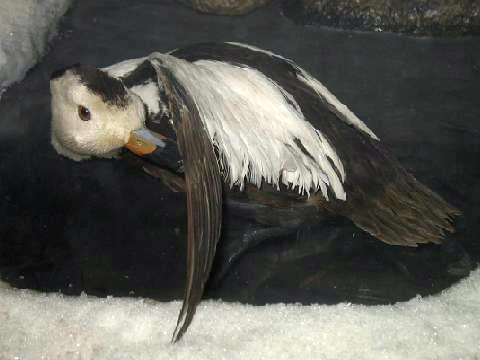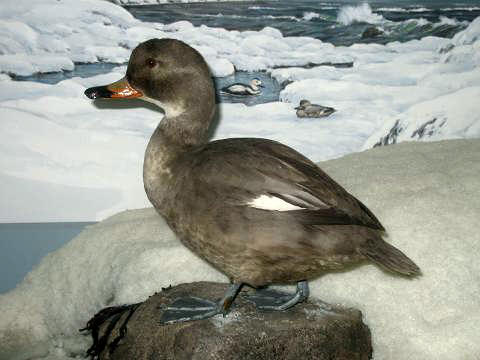- Labrador Duck
Taxobox
name = Labrador Duck
status = EX
status_system = iucn3.1
extinct = c.1878

image_caption = stuffed male specimen,American Museum of Natural History

image2_caption = stuffed Juvenile male specimen, American Museum of Natural History
regnum =Animal ia
phylum = Chordata
classis = Aves
ordo =Anseriformes
familia =Anatidae
genus = "Camptorhynchus"
genus_authority = Bonaparte, 1838
species = "C. labradorius"
binomial = "Camptorhynchus labradorius"
binomial_authority = Gmelin, 1789The Labrador Duck, "Camptorhynchus labradorius", was a striking black and whiteeider -likesea duck that was never known to be common, and is believed to be the firstbird to go extinct inNorth America after1500 . The last Labrador Duck is believed to have been seen atElmira, New York onDecember 12 ,1878 ; the last preserved specimen was shot in1875 onLong Island . It was thought to breed inLabrador , although no nests were ever described, and it wintered fromNova Scotia to as far south asChesapeake Bay .Other names
The Labrador Duck was also known as a Pied Duck, a vernacular name that it shared with the
Surf Scoter and theCommon Goldeneye (and even theAmerican Oystercatcher ), a fact that has led to difficulties in interpreting old records of these species, and also as Skunk Duck. Both names refer to the male's striking white/black piebald coloration. Yet another common name was Sand Shoal Duck, referring to its habit of feeding in shallow water. The closestevolution ary relatives of the Labrador Duck are apparently thescoter s ("Melanitta") (Livezey, 1995).Diet
The Labrador Duck fed on small
mollusc s, and the structure of the bill was highly modified from that of most ducks, having a wide, flattened tip with numerous lamellae inside. In this way it is considered an ecological counterpart of the NorthPacific /NorthAsia nSteller's Eider . Another, completely unrelated, duck with similar (but even more specialized) bill morphology is the AustralianPink-eared Duck , which feeds largely on plankton, but also mollusks; the condition in the Labrador Duck probably resembled that in theBlue Duck most in outward appearance.Extinction
The extinction of the Labrador Duck is still quite unexplained. Although hunted for food, this duck was considered to taste bad and rot quickly and fetch a low price; consequently, it was not sought much by hunters. Alternatively, it is thought that the eggs may have been over-harvested, and it may have been subject to depredations by the feather trade in its breeding area as well. Another possible factor in the bird's extinction was the decline in
mussel s and other shellfish on which they are believed to have fed in their winter quarters, due to growth of population and industry on theEastern Seaboard . Although all sea ducks readily feed on shallow-water molluscs, no Western Atlantic bird species seems to have been dependent on such food as much as the Labrador Duck (Bangs "in" Phillips, 1926).Image gallery
References
* Database entry includes justification for why this species is listed as extinct
* Cokinos, Christopher (2000): "Hope is the Thing with Feathers". New York: Putnam, pp. 281-304. ISBN 1-58542-006-9
* Ducher, William (1894): The Labrador Duck - another specimen, with additional data respecting extant specimens. "Auk" 11: 4-12. [http://elibrary.unm.edu/sora/Auk/v011n01/p0004-p0012.pdf PDF fulltext]
* Forbush, Edward Howe (1912): "A History of the Game Birds, Wild-Fowl and Shore Birds of Massachusetts and Adjacent States." Boston: Massachusetts State Board of Agriculture, pp. 411-416.
* Fuller, Errol (2001): "Extinct Birds", Comstock Publishing, ISBN 0-8014-3954-X, pp. 85-87.
* Livezey, Bradley C. (1995): Phylogeny and Evolutionary Ecology of Modern Seaducks (Anatidae: Mergini). "Condor 97: 233-255. [http://elibrary.unm.edu/sora/Condor/files/issues/v097n01/p0233-p0255.pdf PDF fulltext]
* Phillips, John C. (1922-1926): "A Natural History of Ducks". Boston: Houghton-Mifflin, volume 4, pp. 57-63.
* Madge, Steve & Burn, Hilary (1988): "Waterfowl. An identification guide to the ducks, geese and swans of the world." Boston: Houghton Mifflin, pp. 265-266. ISBN 0-395-46727-6External links
* [http://www.birdlife.org/datazone/species/index.html?action=SpcHTMDetails.asp&sid=488&m=0 BirdLife Species Factsheet]
* [http://www.redlist.org/search/details.php?species=3722 IUCN Red List]
* [http://www.abirdshome.com/Audubon/VolVI/00665.html The Labrador Duck from John James Audubon's Birds of America]
* [http://www.chemunghistory.com/labradorduck.html The Very Last Labrador Duck - Elmira, New York]
* [http://www.qc.ec.gc.ca/faune/oiseaux_menaces/html/eider_labrador_e.html Environment Canada]
* [http://www.virtualmuseum.ca/Exhibitions/Birds/MSS/Anglais/elabrado.htm Swans, Geese, and Ducks of Canada]
* [http://www.uea.ac.uk/bio/people/faculty/reynoldslab/extinction_tableB.htm Marine Extinction Database] University of East Anglia, UK
* [http://nlbif.eti.uva.nl/naturalis/detail?lang=uk&id=52 3D view] of specimens RMNH 110.083 and RMNH 110.084 atNaturalis , Leiden (requiresQuickTime browser plugin).See also
*
Extinct birds
*List of extinct animals
Wikimedia Foundation. 2010.
